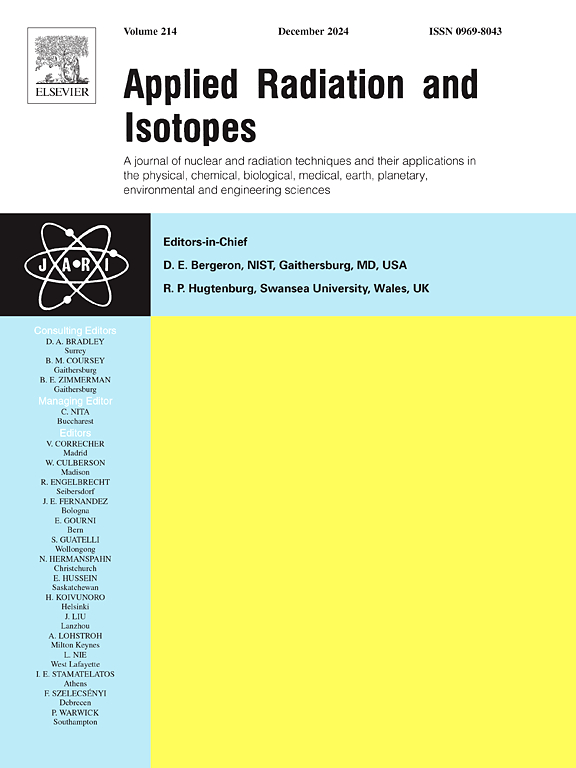Small field commissioning and verification for the uRT-TPOIS radiotherapy treatment planning system
IF 1.8
3区 工程技术
Q3 CHEMISTRY, INORGANIC & NUCLEAR
引用次数: 0
Abstract
Purpose
Stereotactic radiosurgery (SRS) and stereotactic body radiation therapy (SBRT) plans involve high doses and small fields. Standard commissioning procedures typically do not prioritize small fields, which is why the commission parameters of small field models require a comprehensive and precise verification process to ensure accurate dose calculation for SRS/SBRT plans.
Methods
The study employed various methods, including dose validation tests in a water tank with both regular and irregular small fields. The StereoPHAN and SRS MapCHECK were utilized to assess the modelling accuracy of collapse cone convolution (CC) and Monte Carlo (MC) algorithms for both point and planar doses of the small field plans. Additionally, pre-treatment approval of SRS/SBRT plans based on Electronic Portal Imaging Device (EPID) equipped on the machine was conducted. To enhance realism, 19 clinical SRS/SBRT plans were measured and analyzed for their point and planar doses. In addition, a special 27-target plan was measured using ‘gold standard’ film and compared with the calculations based on parameters from the small field commissioning procedures.
Results
The validation tests conducted in the water tank proved to be reliable and accurate for both regular and irregular small fields. The results indicated that the average error of point dose decreased from 2.29 % with parameters based on standard commissioning procedures to 0.64 % with parameters based on small field commissioning procedures. Furthermore, planar doses acquisition included high-dose and non-high-dose planes, resulting in an increase in the average gamma passing rate from 93.15 % to 99.90 %. The gamma passing rates of EPID pre-treatment verifications exceeded 99 % at a criteria of 2mm2 %. These findings demonstrate the effectiveness of small field commissioning procedures in improving the accuracy of dose calculations for SRS/SBRT plans.
Conclusion
This study marks the first time that small field commissions and verifications of CC and MC algorithms in uRT-TPOIS, along with uRT-linac 506c, were conducted. The reliability and accuracy of the calculation algorithms for small field commissions were verified through the comparisons between measurements and calculations. The results showed that both CC and MC algorithms' small field parameters met the clinical requirements with minimal deviations (lower than 2 %) between measurements and calculations. Additionally, EPID was found to be an effective quality assurance tool for SRS/SBRT plans.
ut - tpois放射治疗计划系统的小现场调试和验证
目的立体定向放射外科(SRS)和立体定向全身放射治疗(SBRT)方案涉及大剂量小范围。标准调试程序通常不会优先考虑小区域,这就是为什么小区域模型的调试参数需要一个全面而精确的验证过程,以确保SRS/SBRT计划的准确剂量计算。方法采用常规和不规则小场水罐剂量验证试验等多种方法。利用StereoPHAN和SRS MapCHECK来评估塌陷锥卷积(CC)和蒙特卡罗(MC)算法对小场平面图的点剂量和平面剂量的建模精度。此外,根据机器配备的电子传送门成像装置(EPID)对SRS/SBRT方案进行预处理审批。为了增强真实性,我们测量和分析了19个临床SRS/SBRT计划的点剂量和平面剂量。此外,使用“金标准”薄膜测量了一个特殊的27个目标计划,并将其与基于小型现场调试程序参数的计算结果进行了比较。结果在水箱中进行的验证试验证明,无论对规则场地还是不规则场地,该方法都是可靠和准确的。结果表明,点剂量的平均误差由按标准调试程序计算的2.29%下降到按小场调试程序计算的0.64%。此外,平面剂量获取包括高剂量面和非高剂量面,导致平均伽马通过率从93.15%增加到99.90%。在2mm2 %的标准下,EPID预处理验证的γ通过率超过99%。这些发现证明了小型现场调试程序在提高SRS/SBRT计划剂量计算准确性方面的有效性。本研究标志着首次在ut - tpois以及ut -linac 506c中进行CC和MC算法的小型现场委托和验证。通过测量与计算的对比,验证了小型现场工程计算算法的可靠性和准确性。结果表明,CC和MC算法的小场参数均满足临床要求,测量值与计算值之间的偏差最小(小于2%)。此外,EPID被发现是SRS/SBRT计划的有效质量保证工具。
本文章由计算机程序翻译,如有差异,请以英文原文为准。
求助全文
约1分钟内获得全文
求助全文
来源期刊

Applied Radiation and Isotopes
工程技术-核科学技术
CiteScore
3.00
自引率
12.50%
发文量
406
审稿时长
13.5 months
期刊介绍:
Applied Radiation and Isotopes provides a high quality medium for the publication of substantial, original and scientific and technological papers on the development and peaceful application of nuclear, radiation and radionuclide techniques in chemistry, physics, biochemistry, biology, medicine, security, engineering and in the earth, planetary and environmental sciences, all including dosimetry. Nuclear techniques are defined in the broadest sense and both experimental and theoretical papers are welcome. They include the development and use of α- and β-particles, X-rays and γ-rays, neutrons and other nuclear particles and radiations from all sources, including radionuclides, synchrotron sources, cyclotrons and reactors and from the natural environment.
The journal aims to publish papers with significance to an international audience, containing substantial novelty and scientific impact. The Editors reserve the rights to reject, with or without external review, papers that do not meet these criteria.
Papers dealing with radiation processing, i.e., where radiation is used to bring about a biological, chemical or physical change in a material, should be directed to our sister journal Radiation Physics and Chemistry.
 求助内容:
求助内容: 应助结果提醒方式:
应助结果提醒方式:


